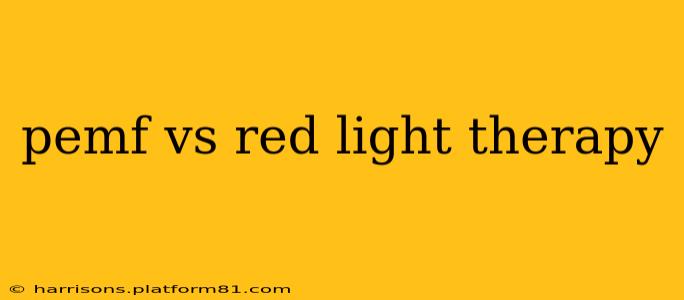Pulsed electromagnetic field (PEMF) therapy and red light therapy (RLT) are both gaining popularity as alternative therapies for a range of health concerns. Both utilize different forms of energy to stimulate cellular function, but they operate through distinct mechanisms and target different aspects of health and wellness. This article will compare and contrast PEMF and RLT, helping you understand their individual benefits, potential drawbacks, and ultimately, which might be a better fit for your specific needs.
What is Pulsed Electromagnetic Field (PEMF) Therapy?
PEMF therapy uses electromagnetic fields to stimulate cells and tissues. Devices generate pulsed electromagnetic waves that penetrate the body, influencing cellular processes at a fundamental level. Proponents suggest this can improve cellular function, reduce inflammation, and accelerate healing.
How Does PEMF Therapy Work?
PEMF therapy works by influencing the electrical activity within cells. Cells naturally have an electrical charge, and PEMF pulses are believed to help restore or enhance this charge, impacting various cellular processes. This can lead to increased ATP production (the cell's energy source), improved blood circulation, and reduced pain and inflammation.
What is Red Light Therapy (RLT)?
Red light therapy, also known as low-level laser therapy (LLLT), utilizes red and near-infrared light to stimulate cellular activity. These wavelengths of light are absorbed by mitochondria, the powerhouses of cells, which then triggers increased cellular energy production and other beneficial cellular effects.
How Does Red Light Therapy Work?
The light from RLT devices is absorbed by photoreceptors within the mitochondria, leading to a cascade of effects including increased ATP production, reduced inflammation, and stimulation of collagen production. This can lead to improved wound healing, reduced pain, and potentially anti-aging effects.
PEMF vs. Red Light Therapy: Key Differences
While both therapies aim to promote cellular healing, they achieve this through different mechanisms:
| Feature | PEMF Therapy | Red Light Therapy |
|---|---|---|
| Mechanism | Electromagnetic fields influence cellular electrical activity | Light absorption by mitochondria stimulates cellular processes |
| Penetration | Deeper penetration into tissues | Less deep penetration, primarily surface tissues |
| Treatment Area | Can treat larger areas of the body | Often applied to more localized areas |
| Application | Usually involves placing a device on or near the body | Involves shining light onto the skin |
| Typical Uses | Pain management, bone healing, improved sleep | Wound healing, anti-aging, pain reduction |
What are the Benefits of PEMF Therapy?
- Pain Management: PEMF therapy shows promise in reducing pain associated with various conditions.
- Improved Sleep: Some studies suggest it can improve sleep quality and duration.
- Bone Healing: It may aid in bone fracture healing and osteoporosis management.
- Reduced Inflammation: It’s believed to reduce inflammation throughout the body.
What are the Benefits of Red Light Therapy?
- Wound Healing: RLT has demonstrated effectiveness in promoting wound healing.
- Anti-Aging Effects: Some studies suggest it can improve skin texture and reduce wrinkles.
- Pain Relief: It can help alleviate pain from various sources.
- Hair Growth Stimulation: It has shown promise in improving hair growth.
Is PEMF Therapy Safe?
PEMF therapy is generally considered safe when used properly. However, it is crucial to use a reputable device and follow the manufacturer's instructions. Individuals with pacemakers or other implanted electronic devices should consult their physician before using PEMF therapy.
Is Red Light Therapy Safe?
Red light therapy is generally considered safe with minimal side effects. However, excessive exposure to high-intensity light can damage the eyes, so it's essential to wear appropriate eye protection during treatment. Some individuals may experience temporary redness or mild skin irritation.
Which is Better: PEMF or Red Light Therapy?
There is no single "better" therapy; the optimal choice depends entirely on individual needs and health concerns. PEMF therapy's deeper penetration may be beneficial for conditions affecting deeper tissues, while red light therapy's focused application is well-suited for localized issues such as wound healing or skin rejuvenation.
Many individuals find it beneficial to use both therapies in conjunction for a more holistic approach. Consulting a healthcare professional experienced in both PEMF and RLT can help determine the most suitable treatment plan for your specific situation.
Can PEMF and Red Light Therapy be Used Together?
Yes, many people use PEMF and red light therapy together. There's no known contraindication to combining these therapies, and some believe that the combined effects offer synergistic benefits. However, always consult with a healthcare professional before implementing a combined treatment plan.
What are the Side Effects of PEMF Therapy?
Generally, side effects of PEMF therapy are minimal. Some individuals report feeling slightly warm or tingling during treatment. However, more significant side effects are rare.
What are the Side Effects of Red Light Therapy?
Red light therapy generally has few side effects. Temporary skin redness or mild irritation is possible, but usually resolves quickly. Eye protection is crucial to avoid potential retinal damage.
This information is for educational purposes only and does not constitute medical advice. Always consult with a healthcare professional before starting any new therapy.
